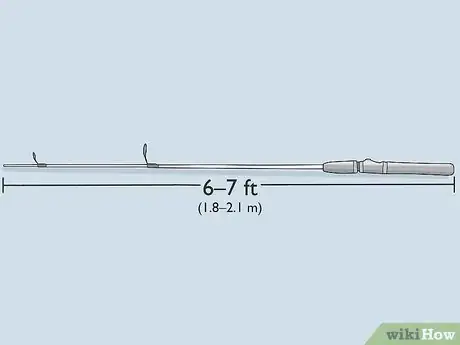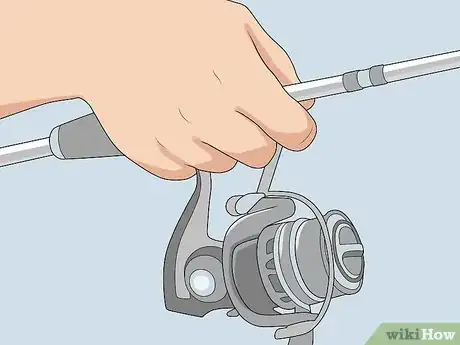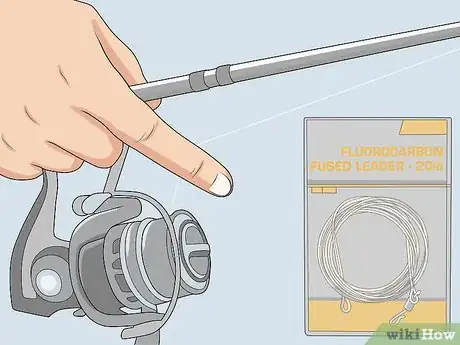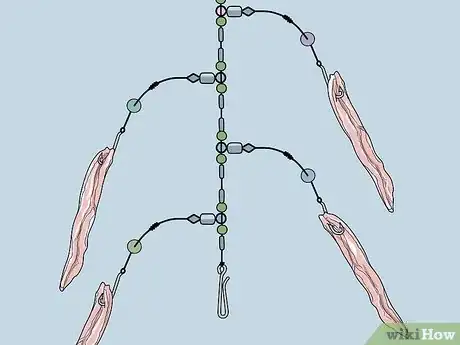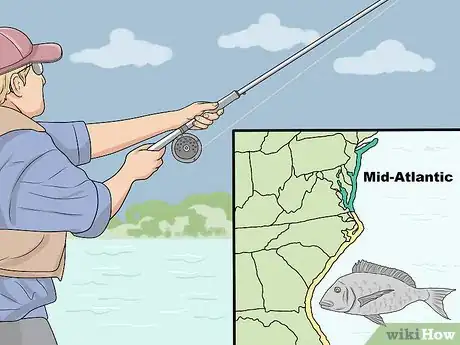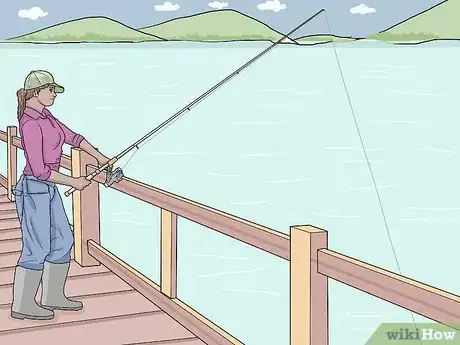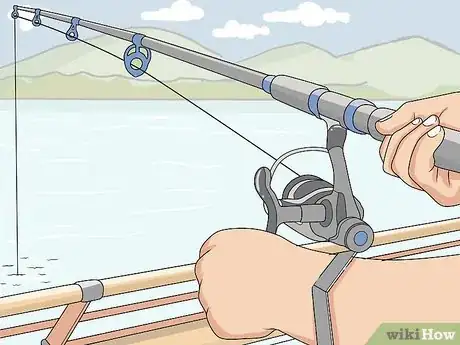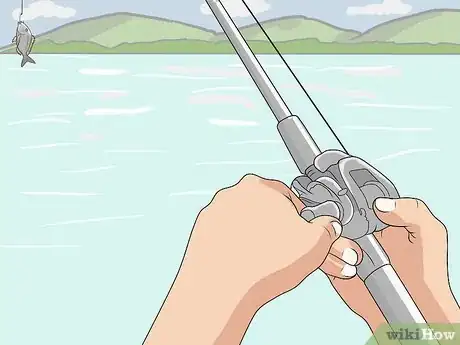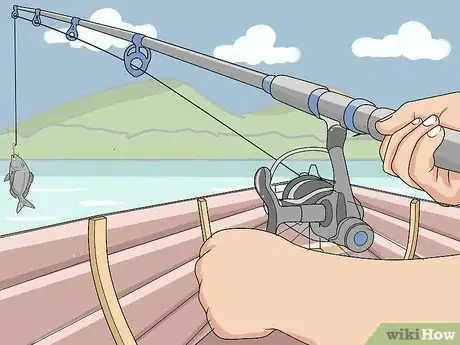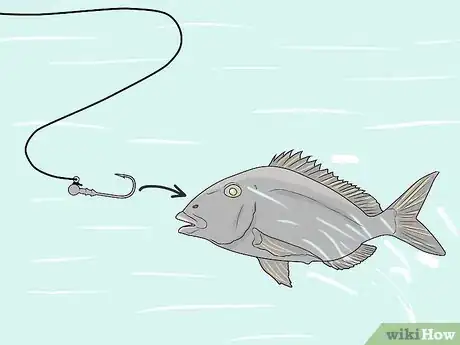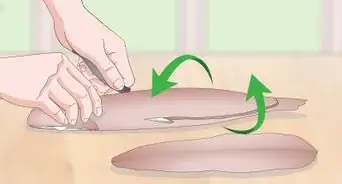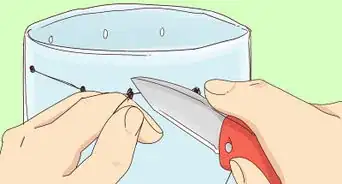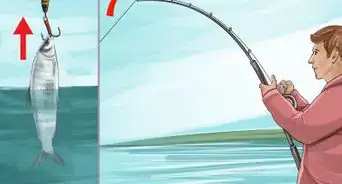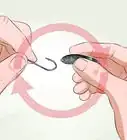This article was co-authored by Michael Reynolds. Michael Reynolds is a Professional Fishing Instructor and the Owner of Long Beach, California Fishing Lessons by Michael Reynolds. In his over 40 years of fishing experience, Michael has become very knowledgeable about the variety of fishing methods and techniques. He is passionate about sharing his knowledge with beginners to experienced anglers. Michael has been guiding and teaching fishing for over five years and is licensed and bonded with the Department of Fish and Wildlife (DFW).
There are 7 references cited in this article, which can be found at the bottom of the page.
This article has been viewed 30,330 times.
There are over 100 species of porgies, and most varieties are aggressive yet fun fish to bait and catch. For the porgy variety known as scup, you’ll want to fish the U.S. mid-Atlantic coast on shore or by boat in late spring and early summer. To catch "scup" porgies, you need the right gear, including a lightweight rod, an ample amount of bait, and lots of smelly chum. With a bit of patience, you’ll be well on your way to reeling in some porgies and using them in a tasty recipe or for show!
Steps
Choosing Your Gear and Bait
-
1Fish for porgies with a 6–7 ft (1.8–2.1 m) lightweight rod. This type of flexible rod provides enough give that the porgy won’t tear its lips as it struggles on the hook. At the same time, you’ll be able to feel light bites that you might not notice with a more rigid rod.[1]
- Choose your fishing rod carefully, and don’t be afraid to spend a good bit of your fishing budget to get the right model. Talk to fellow porgy anglers and knowledgeable fishing supply store employees for advice.
- A good-quality rod that is suited to the type of fish you’re trying to catch gives you much greater “feel” for the fish and control of the line.
-
2Attach a reel that can hold enough line to reach the water’s floor. Porgies are bottom-feeders that eat crabs, clams, and other small sea creatures. That means you need enough line to reach the floor of the body of water where you’re fishing.
- Modern rods and reels typically come together very easily—you’ll often just need to insert the reel’s attachment arm into the designated slot in the rod, then hand-tighten the screw caps on the rod to secure the reel in place. Refer to the manuals for your rod and reel for more specific information.
- Porgies can be found in waters ranging in depth from 6–120 ft (1.8–36.6 m). Plan your reel and line needs accordingly, based on whether you plan to fish from a pier or on a boat in open water.
Advertisement -
3Use a fused line with a fluorocarbon leader. Fused lines are preferable to braided or monofilament lines when fishing for porgies, because they are more abrasion-resistant and less likely to become knotted up in the wind. Pick a fused line that’s rated between 14–20 lb (6.4–9.1 kg), with the lower end of that scale being preferred by most porgy enthusiasts.[2]
- Select a fluorocarbon leader that’s at least 4 ft (1.2 m) in length and rated at 30 lb (14 kg).
- If you’re new to choosing fishing line, don’t hesitate to ask for advice at the bait and tackle shop or along the docks.
-
4Set up your terminal rig with multiple hooks. Clip on a barrel swivel rated for 50 lb (23 kg) at the top of the rig line, and tie or clip on a 4 oz (110 g) bank sinker at the bottom. Tie dropper loops into the line at 12 and 36 in (30 and 91 cm) above the sinker, using your preferred knot. Thread 4/0 beak bait hooks through each loop.[3]
- Clip the other end of the barrel swivel to the fluorocarbon leader line to complete your terminal rig setup.
- It’s important to attach multiple hooks. Porgies are very aggressive and will rip the bait away before you can hook them. Having multiple hooks increases the chances of a hookup.
-
5Try thin strips of packaged clam tongue or belly meat as your bait. Different baits have different benefits. Packaged strips of clam tongue may stay on the hook better, but it's less appealing than belly meat. Packaged belly meat from practically any fish variety may attract porgies better, but it also might attract other types of fish that you aren’t interested in.[4]
- Porgies respond to just about any type of bait as long as it’s cut into small pieces. If the packaged bait isn’t already cut into narrow strips that are about 2 in (5.1 cm) long, use a knife to trim them further.
- Another great bait for porgy is squid strips.
- Talk to other porgy anglers where you’re fishing to get tips on the best bait for that location.
Finding and Casting for Porgies
-
1Fish for “scup” porgies all along the mid-Atlantic coast of the U.S. The porgy species in this region, often called scup, prefer water depths of 6–120 feet (1.8–36.6 m). This means you can find them in open water as well as in bays, harbors, and sounds, and near piers, reefs, and jetties.[5]
- Scup are typically abundant from Cape Hatteras, NC to Cape Cod, MA.[6]
- There are over 100 species of porgy (species sparidae), found in ocean waters all around the world. They share many similarities, but there may be differences in the best ways to catch other species of porgy. Consult with local experts.
-
2Wait for the water temperature to reach 60 °F (16 °C). Porgies are most abundant and active when the water temperature is between 55–75 °F (13–24 °C). Along the U.S. mid-Atlantic coast, this usually carries from around May to late September or early October.[7]
- The spawning season of May and June is often the best time to fish for porgies in this region.
-
3Fish from a boat in the middle of a bay or sound. Most porgies, and especially scup, move with the tides, trolling sandy or rocky bottoms looking for food. This means they often congregate in the deeper waters in the middle of bays and sounds. So, try dropping anchor to fish for porgies in such a location.[8]
- The best advice is to ask the locals where they drop anchor to fish for porgies!
-
4Fish from shore on a pier or jetty. You don’t have to fish from a boat to catch scup or many other varieties of porgy. Piers and jetties often make great fishing spots for scup, especially during times when the tide is coming in, bringing the scup (and their prey) with it.[9]
- Use the same rod, reel, and tackle setup whether you’re fishing from a boat or on shore. You’ll require less fishing line, however, to fish from land into shallower waters.
-
5Drop a chum bucket into the water and check it frequently. Buy a prepared, perforated bucket of frozen chum and lower it into the water with an attached rope. Check the bucket periodically and replace it if it runs low on chum or the smell wears off.[10]
- Alternatively, you can make your own chum bucket with a bit of DIY know-how. Search online or ask an experienced angler for tips.[11]
- As with baits, porgies aren’t too picky about chum. Some anglers say clam chum is most effective, but ground chum works as well. An artificially scented soft bait (such as the brand Berkley Gulp Chum) may hold its scent longer.
-
6Cast your line quickly, but be patient. If you’re fishing from a boat, drop anchor, put in the chum, and cast your line in quick succession—if there are porgies around, they’ll be drawn in quickly! Likewise, if you’re fishing from a pier or jetty, get your line in the water quickly and in proximity to the chum.[12]
- While you want to get your line in the water fast, you may want to be patient after you feel the tug of a fish nibbling on the bait. You’ll often find that a second porgy will be enticed by the other bait on your line—providing you with a potential double haul!
- Some anglers find that smaller porgies congregate right at the chum, while the bigger ones remain near the fringes. So, you may want to try casting nearby, but not right at, your chum.
Reeling in a Porgy
-
1Hook the porgy by slowly raising the rod about 3 ft (0.91 m). Porgies are scrappy fish that can snatch the bait without taking the hook. Instead of yanking up on the rod when you feel a tug, pull up slowly to draw the fish onto the hook.[13]
- Once you’ve lifted the rod and still feel the tug of the fish on the line, you can start to slowly reel your catch in.
-
2Get the porgy from the surface to the boat or shore quickly. Porgies fight erratically and vigorously, so you need to reel them in slowly but get them out of the water quickly. If you’re on a boat, lower the tip of the rod about 1 ft (30 cm) above the water when the fish is just below the surface. Then, lift the fish out of the water, over the rail, and into your boat.[14]
- You probably won’t be able to get your rod tip so close to the water if you’re fishing from a pier or similar spot on land, buy you should still focus on lifting and transporting the porgy from the water quickly.
- Move quickly, but not so quickly that you’re out of control.
-
3Unhook your haul and release or keep it. Work carefully as you unhook the fish, since porgies have sharp sharp dorsal spines that can cut through thin fabrics and your skin. Once you successfully remove the hook, you can either release the fish back in the water or save it for a meal.[15]
- Like most aspects of fishing, the best way to master unhooking a fish is to watch, chat with, learn from, and fish alongside experienced anglers.
- If you’re planning to eat your fish, baked porgy is a nice alternative to chicken or beef.[16]
Warnings
- Depending on your location, you may need a fishing license in order to fish for porgies. Also, there may be daily catch limits for porgies. Check with the relevant government agency in the area to determine any requirements or restrictions.⧼thumbs_response⧽
Things You’ll Need
- Lightweight rod
- Reels
- Fused line
- Fluorocarbon leader
- Barrel swivel
- Bank sinker
- Beak bait hooks
- Bait strips
- Chum
References
- ↑ https://neangling.com/recommended-tackle/porgy-tackle/
- ↑ https://neangling.com/recommended-tackle/porgy-tackle/
- ↑ https://neangling.com/recommended-tackle/porgy-tackle/
- ↑ http://neangling.com/recommended-tackle/porgy-tackle/
- ↑ https://www.ct.gov/deep/cwp/view.asp?a=2696&q=322738&deepNav_GID=1647
- ↑ https://neangling.com/recommended-tackle/porgy-tackle/
- ↑ https://nypost.com/2005/08/17/porgies-hit-peak-this-time-of-year/
- ↑ https://nypost.com/2005/08/17/porgies-hit-peak-this-time-of-year/
- ↑ https://neangling.com/recommended-tackle/porgy-tackle/
- ↑ http://neangling.com/recommended-tackle/porgy-tackle/
- ↑ https://goneoutdoors.com/make-chum-buckets-5547820.html
- ↑ https://neangling.com/recommended-tackle/porgy-tackle/
- ↑ https://www.captree.com/specks/porgy.htm
- ↑ https://www.captree.com/specks/porgy.htm
- ↑ https://neangling.com/recommended-tackle/porgy-tackle/
- ↑ https://www.cookstr.com/Fish-Recipes/Baked-Porgy
